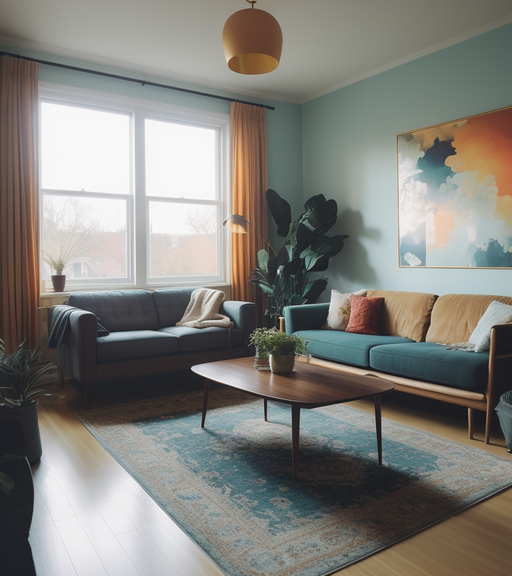How Relevant is Color In Interior Design?

Color is one of the most important elements of interior design. It can create different moods, atmospheres, and impressions in a space. Color can also affect how we perceive the size, shape, and temperature of a room. For example, warm colors like red, orange, and yellow can make a space feel cozy, inviting, and energetic, while cool colors like blue, green, and purple can make a space feel calm, soothing, and spacious.
Color can also express our personality, taste, and style. Choosing the right color scheme for a space can enhance its beauty, functionality, and harmony. Color can also influence our emotions, behavior, and well-being. For example, some colors can stimulate our creativity, productivity, and concentration, while others can relax our mind, body, and spirit. Color is a powerful tool that can transform any space into a unique and personal sanctuary.
Color Vibrancy and its Influence
Color vibrancy in interior design is the use of bright, saturated and contrasting colors to create a lively and stimulating mood in a space. Color vibrancy can be achieved by using primary colors, such as red, yellow and blue, or by mixing complementary colors, such as purple and green, or orange and turquoise. Color vibrancy can also be enhanced by adding patterns, textures and accessories that feature vivid hues.
Color vibrancy can make a space more dynamic, energetic and fun, but it can also be overwhelming or distracting if used excessively or without balance. According to color psychology, vibrant colors can evoke positive emotions, such as happiness, excitement and creativity, but they can also cause negative reactions, such as anxiety, irritation or fatigue.
Guidelines for using vibrant colors in interior design
Vibrant colors can add energy, personality and warmth to any interior design project. However, using them effectively requires some careful planning and balance. Here are some of the best guidelines to use vibrant colors in interior design:
Choose a color scheme. Before you start painting or buying furniture, you need to decide on a color scheme that works for your space and style. You can use a color wheel to find complementary, analogous or triadic colors that create harmony and contrast. Alternatively, you can use a tool like Adobe Color to generate color schemes based on different moods, trends or inspirations.
Use the 60-30-10 rule. A common rule of thumb for using vibrant colors is to follow the 60-30-10 ratio. This means that 60% of your room should be a dominant color, 30% should be a secondary color and 10% should be an accent color. This way, you can create a balanced and cohesive look without overwhelming the eye. For example, you can paint your walls with a neutral color (60%), add a sofa and curtains in a vibrant color (30%) and accessorize with pillows and art in another vibrant color (10%).
Add some neutrals. Another way to tone down the intensity of vibrant colors is to mix them with some neutrals, such as white, black, gray or beige. Neutrals can create a sense of calmness and sophistication, as well as highlight the beauty of the vibrant colors. You can use neutrals for your flooring, ceiling, trim or furniture pieces that you want to blend in. It is important to highlight the importance of choosing the right furniture for this aspect! A good recommendation? The Togo Sofa, without doubt! Check it out over here
Play with patterns and textures. Adding some patterns and textures can also enhance the visual interest and depth of your interior design. You can use wallpaper, rugs, cushions, throws or artwork that feature geometric, floral or abstract patterns in vibrant colors. You can also use different materials and fabrics, such as wood, metal, leather or velvet, to create contrast and dimension.
Experiment with lighting. Lighting can have a big impact on how vibrant colors look in your interior design. Depending on the time of day, the direction of the light and the type of light source, the colors can appear brighter, darker, warmer or cooler. You can experiment with different types of lighting, such as natural light, ambient light, task light or accent light, to create different moods and effects. You can also use mirrors, metallic or crystals to reflect and amplify the light and the colors.
Using Vibrant Colors

One of the ways to create a nice use of vibrant colors is to use them as accents in a neutral or monochromatic space. For example, you can add some bright pillows, rugs, lamps or artworks to a white, gray or beige room and create a lively contrast. Another way to use vibrant colors is to mix and match them in a harmonious palette that reflects your personality and mood.
You can choose colors that are complementary, analogous or triadic on the color wheel and apply them to different elements of your interior design, such as walls, furniture, curtains or accessories. A third way to use vibrant colors is to create a focal point in your room that draws attention and makes a statement. You can paint one wall in a bold color, such as red, yellow or turquoise, or use a wallpaper with a vibrant pattern. You can also use a colorful piece of furniture, such as a sofa, chair or table, or a striking artwork, such as a painting, sculpture or mural.
Many people are afraid of using vibrant colors in their interior design, thinking that they will clash or overwhelm the space. However, vibrant colors can actually create a lively and inviting atmosphere, if used wisely and in moderation.

Leave a Reply